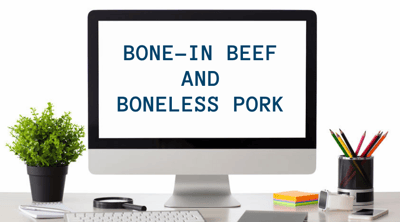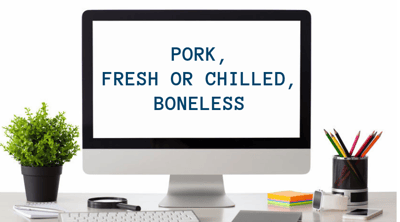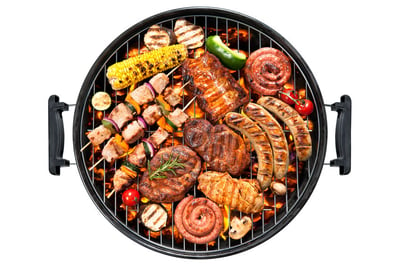Single Window Initiative (SWI) - Survival Guide #2: Beef and Pork
The new SWI landscape
The Single Window Initiative means several changes for importers:
- how you need to submit documentation is in flux;
- when that documentation is needed has changed; and
- which documentation is required is also shifting.
 Our goal is to help you understand what is expected for the new “how, when, and what” of SWI requirements relating to the items you ship. These updates guide importers through specific commodities or categories of commodities, and the Participating Government Agencies (PGAs) that are affected.
Our goal is to help you understand what is expected for the new “how, when, and what” of SWI requirements relating to the items you ship. These updates guide importers through specific commodities or categories of commodities, and the Participating Government Agencies (PGAs) that are affected.
How, when, and what
- Single Window Initiative requires all import documentation to be prepared and submitted before the shipment reaches customs.
- SWI is a new way of submitting documentation. All docs will be submitted using the Integrated Import Declaration (IID). Some of the requirements for how you submit are changing. For example: some documents that needed to be faxed now require an uploaded electronic image or just the document number.
- There may be changes to which documents are required under SWI.
- The launch date of SWI is still unknown, but it’s time to get proactive and adjust your workflow to ensure paperwork is ready before you ship.
Importing bone-in beef and boneless pork under SWI

This week, we guide you through two example commodities.
Beef, other bone in (short ribs, back ribs, etc.) imported from New Zealand, which is regulated by:
CFIA: Canadian Food Inspection Agency
GAC: Global Affairs Canada
Pork fresh or chilled, boneless, imported from South Dakota, U.S., which is regulated by:
CFIA: Canadian Food Inspection Agency
Under SWI, the requirements for bone-in beef and boneless pork are largely the same with a few specific exceptions.
Beef, other bone in (imported from New Zealand)
- Other Government Department (OGD) extension code, which gives a more complete description of the product: Beef, other bone in.
- End use code (which describes the end use of the product): Human consumption.
- Miscellaneous code (additional information): Stamped, unstamped, fully marked, etc.
- Country of Origin: New Zealand.
- Registration requirements, which include: transport carrier, foreign processing establishment, packaging type, number of packages, total weight/volume and total weight unit of measure, export establishment, shipping marks, grade, seal number, Canadian meat inspection establishment (other than U.S. shipments), and container number.
- For GAC, beef is on a TRQ (Tariff Rate Quota), so importers must apply for an Import permit.
- The Requirement ID and Version (codes necessary to ensure the proper information is being sent) are no longer required.
- Official Meat Inspection Certificate now required as Materialized Documents (electronic images sent on transmission), not as faxed documents.
- The Safe Food for Canadian License Official Meat Inspection Certificate is now required as a De-materialized Document (no images required, just license number), not as a faxed document.
- For GAC, a document number 2003 (shipment-specific permit) is required and your permit number is then added as a reference number. This number is added to the IID, no longer to the shipment transmission.
Pork, fresh or chilled, boneless
- Other Government Department (OGD) extension code, which gives a more complete description of the product: Pork, fresh or chilled, boneless.
- End use code (which describes the end use of the product): Human consumption.
- Miscellaneous code (additional information): Stamped, unstamped, fully marked, etc.
- Country of Origin: U.S., South Dakota.
- Registration requirements, which include: transport carrier, foreign processing establishment, packaging type, number of packages, total weight/volume and total weight unit of measure, export establishment, shipping marks, seal number, Canadian meat inspection establishment (other than U.S. shipments), and container number.
- The Requirement ID and Version (codes necessary to ensure the proper information is being sent) are no longer required.
- Official Meat Inspection Certificate now required as Materialized Documents (electronic images sent on transmission), not as faxed documents.
- The Safe Food for Canadian License is now required as a De-materialized Document (no images required, just license number), not as a faxed document.
Why importers need to know
Under the new SWI, it’s important that you understand which Participating Government Agencies (PGAs) are regulating your products. Some products are regulated by multiple PGAs, and the PGAs regulating your products may have changed under SWI. Additionally, each PGA and the CBSA can issue penalties for incorrect and missing documents. Understanding what information and documentation is needed for clearance will make the clearance process into Canada smoother and more efficient.
Our guide to importing meat
If you are importing meat, you’ll engage with Canadian Food Inspection Agency (CFIA) and in some cases Global Affairs Canada (GAC).
Four things to consider when importing meat:
- What meat product are you importing? Each animal has specific requirements, and often different cuts or preparations of meat have unique requirements as well.
- Check the admissibility requirements from CFIA. Is the exporter eligible to export to Canada? Are the goods allowed to come in from that country? Does the item require a CFIA import permit?
- EIPA Quota. If the goods fall under Global Affairs, know your status on the Export and Import Permits Act (EIPA) Quota. If you do not have status, a duty will be payable. Each year, the government sets quotas for specific products that are imported into Canada. These quotas are intended to protect the Canadian industry who also produces meat products. Importers need to apply to receive an allocation amount of the Tariff Rate Quota, then apply for a permit for the amount they import until their quota is used up.
- Pre-Alert. Once all the requirements are fully met, your customs broker or consultant will ask you to provide them with Pre-Alert, which advises them on:
- where the goods will cross;
- what re-inspection establishment in Canada they want to use for re-inspection of meat (if it’s required); and
- which vendors/exporters are the products are from.
For SWI, being proactive is your best strategy—gather all your information and documentation as far in advance as possible. Importers who know the requirements for the products they’re importing, and understand the new processes under SWI, will have a much smoother import experience.
As you adjust to the new requirements and workflow of the Single Window Initiative, we're here to help. Our customs team is ready to help you understand the SWI and its new requirements for your commodities—contact us today!
SWI. It's what we do.

Latest Articles
- CBSA Verification Priorities - January 2026
- 7 ways Canadian importers reduce risk when ordering overseas
- Watch out for these extra charges on your freight bill
- Key differences between duty drawbacks and duty refunds for importers
- Mitigating container shortages and rising shipping prices for ocean imports
